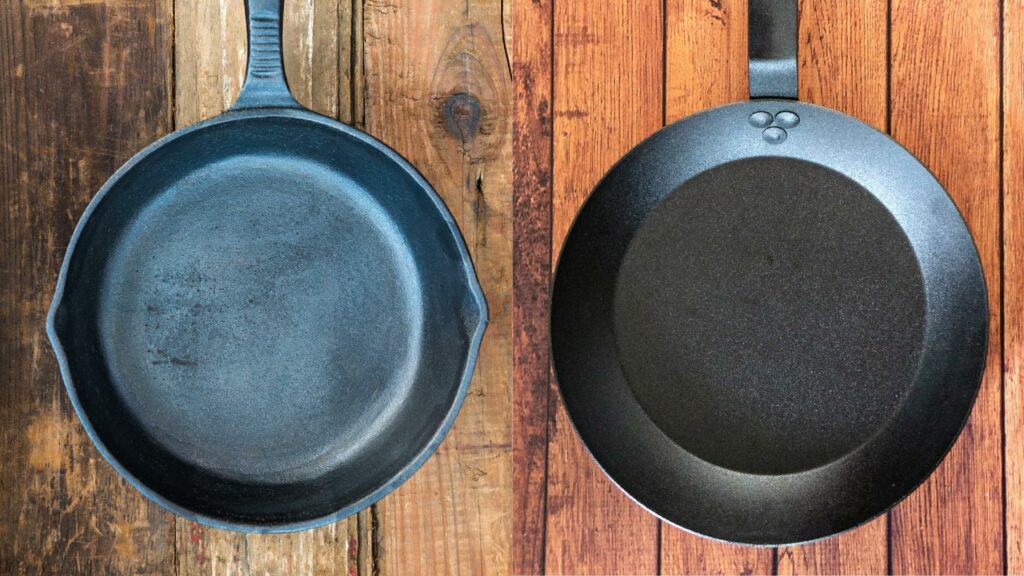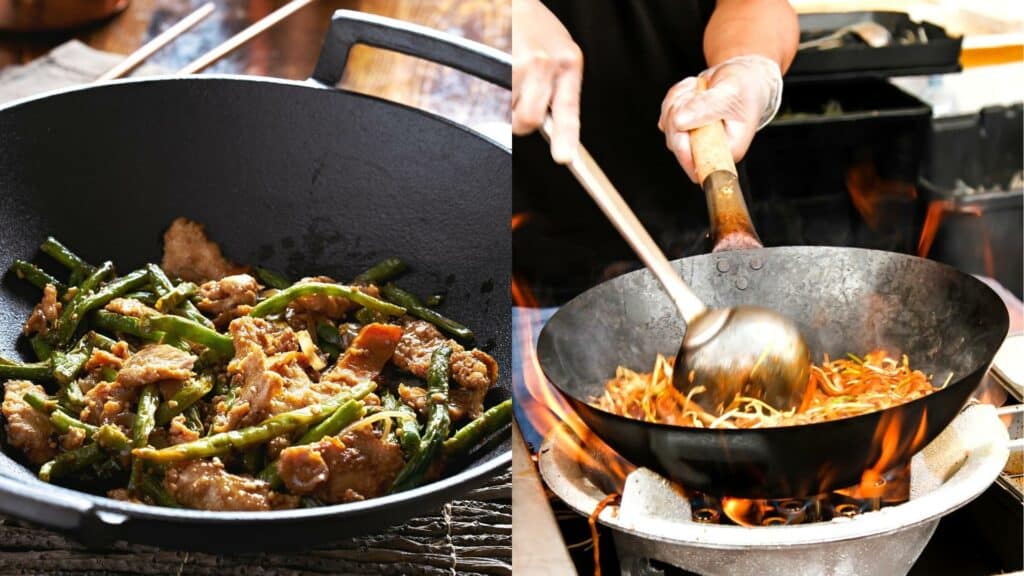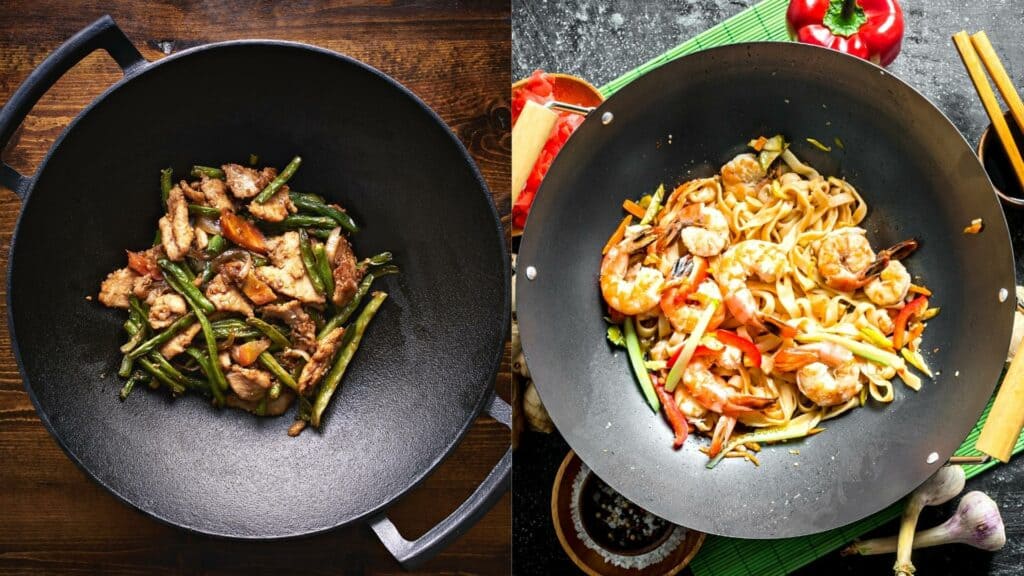If you’re here, then it means you’re doing research, aren’t you?
That’s great! But it also means that you can’t decide between cast iron or carbon steel, right?
I had the same dilemma, there were so many possible choices and variables that I got paralysis by analysis. And seeing that many people are having the same problems I had, I decided to put together this.
In this article, I’m going to try to make it a bit easier for you by giving you the pros and cons of both, in a clear no-fluff way, to help you make that final decision. Let’s get started!
Is the Seasoning Process Similar?

If you’ve used either of these types of cookwares, then you’ll know that they need seasoning, both can achieve surprisingly great levels of non-stick. And with the proper preheating and technique, I haven’t had a stuck egg in forever.
Even though cast iron is more porous and rough, for a wok in carbon steel and a wok in cast iron, the seasoning process in very similar, practically identical. The only thing that I would change is the oil you use to season them.
Lots of cast iron enthusiast use flaxseed oil to season their skillet. After doing hours of research, I’ve found that, for carbon steel, you want to use other high smoke point oils. That’s because lots of carbon steel users have found that flaxseed flakes off a lot and in big chunks.
The theory is that, since cast iron is more porous, the flaxseed oil has a place to “stay attached” to the surface. On the contrary, carbon steel is smooth and not as porous as cast iron, which is why people experience flaking.
Are the Non-stick Capabilities Similar?

For carbon steel woks, if the wok is seasoned properly, I would say it has higher non-stick capabilities than a cast iron wok at the start.
But both can become similarly non-stick. It just might require a bit more time with a cast iron wok. Other than that, I believe they’re similar once they’re very well seasoned.
Now, when it comes to cooking, it’s just about even. And in both cases, it’s pretty fast. I’d say that carbon steel will cook slightly faster, since you don’t need to preheat as long as cast iron before you can start to cook.
Cast Iron Wok

Cast iron is used for all kinds of cookware, and for good very reasons, it’s durable, sturdy and lasts for a lifetime. Not only that but it’s able to withstand very high temperatures, that’s why you can see it’s commonly used in woks, where the ability to go that high is almost essential.
Here we’re going to take a look at the main pros and cons of a cast iron wok:
Pros
Retains a Lot Of Heat
Cast iron has a lot of mass, meaning it can hold more heat for a long period of time. So, when a piece of cast iron gets hot, it stays hot for a very long time.
Super Durable
You’ve probably seen it before, a cast iron skillet being passed from your grandma or grandpa, to your parents and maybe now you have that same piece of cast iron in your own home. That’s because cast iron is super durable, hard to break and can take quite a beating.
Familiar Surface
In many homes, you’re going to find a cast iron piece somewhere, which means for many this will be a familiar surface to cook food on. That in itself removes a lot of doubt when you cook in a new piece of cookware for the first time.
Cons
Heavy
Have you ever seen an expert cooking with a wok? There’s lots of tossing of the food to get that famous “wok hei” (breath of the wok). Well, if you’re going with cast iron, you can say goodbye to that, unless you’re strong, you won’t be able to toss food. You’ll have to rely on your spatula to do that.
Doesn’t Conduct Heat Well
Cast iron doesn’t conduct heat really well, people seem to get that confused a lot. It can retain heat really well because of its poor heat conductivity. So if you have a cast iron wok, you’re going to need to preheat your wok for a longer period of time to get it where you need it to be.
Carbon Steel Wok

Carbon steel is basically the standard for woks. It’s lighter than cast iron, so it’s definitely possible to pick up the wok to toss your food around, it heats quite fast and still retains a good amount of heat, and it’s cheaper than cast iron too.
Here are some more pros and cons in details about carbon steel woks:
Pros
Lightweight
In comparison to cast iron, carbon steel wok are much lighter, making them the ideal material to choose if you’re looking to toss your food around like a wok master and get that “wok hei”.
Quick To Heat Up
The whole thing about wok cooking is being fast. That includes heating your wok. Even if you’re only using a home stovetop, in just a few minutes your wok can become ripping hot.
Better Reactivity
Given that carbon steel woks are usually thinner, around 1.5-2 mm, they hold only just enough heat to cook properly and usually require a high heat. Meaning, they will react to your heat adjustments much better than a cast iron wok, which will keep that heat for a very long time.
Very Durable
Carbon steel has been used for a very long time not only for woks but also frying pans and many other types of cookware, like a paella pan. Carbon steel is just as durable as cast iron, and some argue that it’s more durable because carbon steel is “softer” than cast iron, which is a bit more brittle. I’m sure you’ve seen a cracked cast iron before.
More Affordable
Since carbon steel woks oftentimes use less material than a cast iron wok, and the process can be made entirely by machine. Carbon steel is going to cost a lot less than its counterpart. I’ve seen woks that cost as little as $10.
Cons
Needs Very High Heat
This was basically the only con I could really think about. The thin carbon steel can’t hold a lot of heat, which is the main component of wok cooking, that means you will need quite the hot flame to properly cook restaurant style dishes with similar results. Some people have resorted to outdoor wok burners to solve that issue.
Conclusion
Both options are great. However, there are minor, slight differences when you start actually cooking. Cast iron may take longer to preheat, and you might notice a bigger difference between the temperature of the center of the wok and the sides, much bigger than the norm in some cases.
Either way, it’s hard to go wrong with either after you’ve learned how to work with them properly. Remember to always care for them and keep them seasoned regularly, to prevent rust from happening, and to always have a non-stick surface to cook delicious food on.
